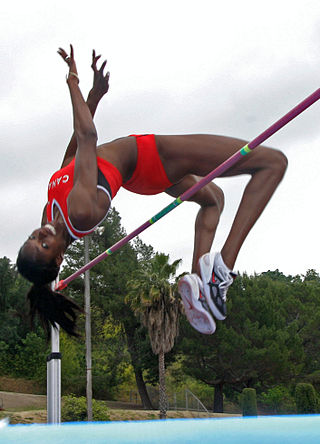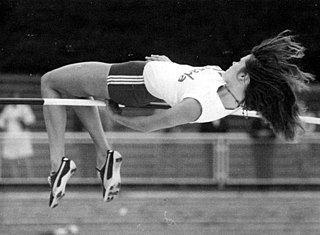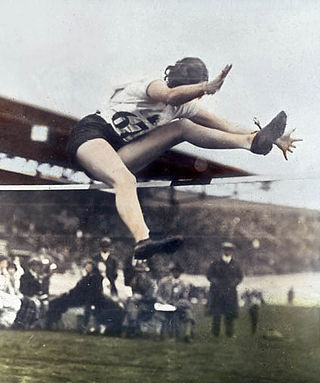
The high jump is a track and field event in which competitors must jump unaided over a horizontal bar placed at measured heights without dislodging it. In its modern, most-practiced format, a bar is placed between two standards with a crash mat for landing. Since ancient times, competitors have introduced increasingly effective techniques to arrive at the current form, and the current universally preferred method is the Fosbury Flop, in which athletes run towards the bar and leap head first with their back to the bar.

The long jump is a track and field event in which athletes combine speed, strength and agility in an attempt to leap as far as possible from a takeoff point. Along with the triple jump, the two events that measure jumping for distance as a group are referred to as the "horizontal jumps". This event has a history in the ancient Olympic Games and has been a modern Olympic event for men since the first Olympics in 1896 and for women since 1948.

Pole vaulting, also known as pole jumping, is a track and field event in which an athlete uses a long and flexible pole, usually made from fiberglass or carbon fiber, as an aid to jump over a bar. Pole jumping competitions were known to the Mycenaean Greeks, Minoan Greeks and Celts. It has been a full medal event at the Olympic Games since 1896 for men and since 2000 for women.

The triple jump, sometimes referred to as the hop, step and jump or the hop, skip and jump, is a track and field event, similar to long jump. As a group, the two events are referred to as the "horizontal jumps". The competitor runs down the track and performs a hop, a bound and then a jump into the sand pit. The triple jump was inspired by the ancient Olympic Games and has been a modern Olympics event since the Games' inception in 1896.
Figure skating jumps are an element of three competitive figure skating disciplines: men's singles, women's singles, and pair skating – but not ice dancing. Jumping in figure skating is "relatively recent". They were originally individual compulsory figures, and sometimes special figures; many jumps were named after the skaters who invented them or from the figures from which they were developed. It was not until the early part of the 20th century, well after the establishment of organized skating competitions, when jumps with the potential of being completed with multiple revolutions were invented and when jumps were formally categorized. In the 1920s Austrian skaters began to perform the first double jumps in practice. Skaters experimented with jumps, and by the end of the period, the modern repertoire of jumps had been developed. Jumps did not have a major role in free skating programs during international competitions until the 1930s. During the post-war period and into the 1950s and early 1960s, triple jumps became more common for both male and female skaters, and a full repertoire of two-revolution jumps had been fully developed. In the 1980s men were expected to complete four or five difficult triple jumps, and women had to perform the easier triples. By the 1990s, after compulsory figures were removed from competitions, multi-revolution jumps became more important in figure skating.

Jumping or leaping is a form of locomotion or movement in which an organism or non-living mechanical system propels itself through the air along a ballistic trajectory. Jumping can be distinguished from running, galloping and other gaits where the entire body is temporarily airborne, by the relatively long duration of the aerial phase and high angle of initial launch.

Richard Douglas Fosbury was an American high jumper, who is considered one of the most influential athletes in the history of track and field. He won a gold medal at the 1968 Olympics, revolutionizing the high jump event with a "back-first" technique now known as the Fosbury flop. His method was to sprint diagonally towards the bar, then curve and leap backward over the bar, which gave him a much lower center of mass in flight than traditional techniques. Debbie Brill was developing her similar "Brill Bend" around the same time. This approach has seen nearly universal adoption since Fosbury's performance in Mexico. Though he never returned to the Olympics, Fosbury continued to be involved in athletics after retirement and served on the executive board of the World Olympians Association.
Because ballet became formalized in France, a significant part of ballet terminology is in the French language.

Plyometrics, also known as jump training or plyos, are exercises in which muscles exert maximum force in short intervals of time, with the goal of increasing power (speed-strength). This training focuses on learning to move from a muscle extension to a contraction in a rapid or "explosive" manner, such as in specialized repeated jumping. Plyometrics are primarily used by athletes, especially martial artists, sprinters and high jumpers, to improve performance, and are used in the fitness field to a much lesser degree.

Debbie Arden Brill, is a Canadian high jump athlete who at the age of 16 became the first North American woman to clear 6 feet. Her reverse jumping style—which is now almost exclusively the technique of elite high jumpers—was called the Brill Bend and was developed by her when she was a child, around the same time as Dick Fosbury was developing the similar Fosbury Flop in the US. Brill won gold in the high jump at the 1970 Commonwealth Games, and at the Pan American Games in 1971. She finished 8th in the 1972 Summer Olympics, then quit the sport in the wake of the Munich massacre, returning three years later. She won gold at the IAAF World Cup in 1979 and at the 1982 Commonwealth Games. She has held the Canadian high jump record since 1969, and set the current record of 1.99 meters in 1982, a few months after giving birth to her first child.

The first world record in the men's high jump was recognized by the International Association of Athletics Federations (IAAF) in 1912.
Igor Vasilyevich Paklin is a retired Kyrgyz athlete who represented USSR and later Kyrgyzstan. He trained at Armed Forces sports society in Frunze.

The straddle technique was the dominant style in the high jump before the development of the Fosbury Flop. It is a successor of the Western roll, for which it is sometimes confused.
The Western roll was a high jump technique invented by George Horine of Stanford University. This technique was succeeded by the straddle.
The eastern cut-off is a variant of the "scissors" high jump style involving a layout. This enables the jumper to clear a higher bar than with the traditional scissors style while still landing on the feet. The technique is generally credited to Michael Sweeney of the New York Athletic Club, who used it in 1895 to set a world record of 6 ft 5 5/8 inches . The style came to be called "eastern" because of its origin on the US east coast, after the invention of the rival "western roll" style by George Horine on the west coast (Stanford). Horine was in fact the first to improve on Sweeney's record, when he cleared 6 ft 7 inches in 1912.

The scissors is a style used in the athletics event of high jump.
This is a general glossary of the terms used in the sport of gymnastics.

The front crawl or forward crawl, also known as the Australian crawl or American crawl, is a swimming stroke usually regarded as the fastest of the four front primary strokes. As such, the front crawl stroke is almost universally used during a freestyle swimming competition, and hence freestyle is used metonymically for the front crawl. It is one of two long axis strokes, the other one being the backstroke. Unlike the backstroke, the butterfly stroke, and the breaststroke, the front crawl is not regulated by the FINA. Hence, in "freestyle" competitive swimming events, any stroke or combination of strokes is permissible. This style is sometimes referred to as the Australian crawl although this can sometimes refer to a more specific variant of front crawl.

The men's high jump was one of four men's jumping events on the Athletics at the 1968 Summer Olympics program in Mexico City. Thirty-nine athletes from 25 nations competed. The maximum number of athletes per nation had been set at 3 since the 1930 Olympic Congress. Dick Fosbury won by using a backward jumping style that was called the Fosbury Flop. This was the unveiling of the new style on the world stage. The style completely revolutionized the sport. By the mid 1970s and ever since, virtually all of the top competitors were using the new style.

A kick is a skill in association football in which a player strikes the ball with their foot. Association football, more commonly referred to as football and also known as soccer, is a sport played world-wide, with up to 265 million people around the world participating on a yearly basis. Kicking is one of the most difficult skills to acquire in football. This skill is also vitally important, as kicking is the way in which passes are made and the primary means by which goals are scored.














